
The Hollywood Hotel was a famous hotel, society venue of early Hollywood, and landmark, formerly located at 6811 Hollywood Boulevard, on the north side, extending from Highland Avenue to Orchid Avenue, in central Hollywood, Los Angeles, California.
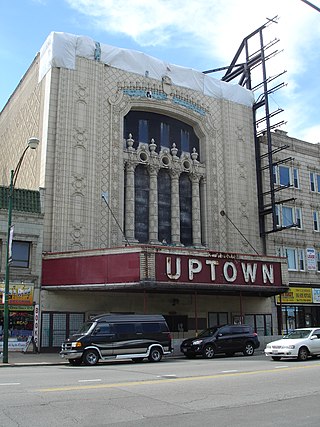
A movie palace is a large, elaborately decorated movie theater built from the 1910s to the 1940s. The late 1920s saw the peak of the movie palace, with hundreds opening every year between 1925 and 1930. With the advent of television, movie attendance dropped, while the rising popularity of large multiplex chains in the 1980s and 1990s signaled the obsolescence of single-screen theaters. Many movie palaces were razed or converted into multiple-screen venues or performing arts centers, though some have undergone restoration and reopened to the public as historic buildings.

Broadway, until 1890 Fort Street, is a thoroughfare in Los Angeles County, California, United States. The portion of Broadway from 3rd to 9th streets, in the Historic Core of Downtown Los Angeles, was the city's main commercial street from the 1910s until World War II, and is the location of the Broadway Theater and Commercial District, the first and largest historic theater district listed on the National Register of Historic Places (NRHP). With twelve movie palaces located along a six-block stretch of Broadway, it is the only large concentration of movie palaces left in the United States.

The Homer Laughlin Building, at 317 South Broadway in Downtown Los Angeles, is a landmark building best known for its ground floor tenant the Grand Central Market, the city's largest and oldest public market that sees 2 million visitors a year.

Stiles Oliver Clements was an architect practicing in Los Angeles and Southern California.

The Million Dollar Theatre at 307 S. Broadway in Downtown Los Angeles is one of the first movie palaces built in the United States. It opened in 1917 with the premiere of William S. Hart's The Silent Man. It's the northernmost of the collection of historical movie palaces in the Broadway Theater District and stands directly across from the landmark Bradbury Building. The theater is listed in the National Register of Historic Places.
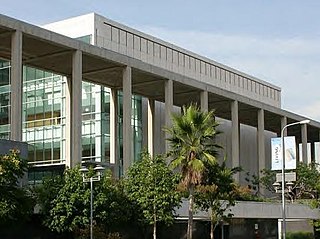
The Ahmanson Theatre is one of the four main venues that compose the Los Angeles Music Center.
The Paramount Theatre in Los Angeles was a movie palace opened in January 1923 as Grauman's Metropolitan Theatre. It was built by impresario Sid Grauman, who had already built the Million Dollar Theatre a few blocks away, but who is best remembered today for his two Hollywood movie palaces, Grauman's Chinese Theatre and Grauman's Egyptian Theatre.

Ethel Grey Terry was an American actress of the silent era. She is best remembered for her role in The Penalty with Lon Chaney.
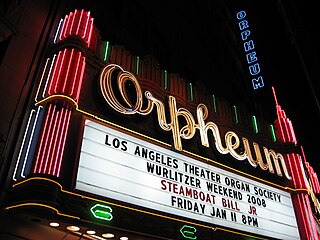
The Orpheum Theatre at 842 S. Broadway in Downtown Los Angeles opened on February 15, 1926, as the fourth and final Los Angeles venue for the Orpheum vaudeville circuit. After a $3 million renovation, started in 1989, it is the most restored of the historical movie palaces in the city. Three previous theatres also bore the name Orpheum before the one at 842 Broadway was the final one with that moniker.

The Ace Hotel Downtown Los Angeles, originally built as the California Petroleum Corporation Building and later known as the Texaco Building, is a 243 ft (74 m), 13-story highrise hotel and theater building located at 937 South Broadway in downtown Los Angeles, California. It was the tallest building in the city for one year after its completion in 1927, and was the tallest privately owned structure in Los Angeles until 1956. Its style is Spanish Gothic, patterned after Segovia Cathedral in Segovia, Spain.

The Broadway Theater District in the Historic Core of Downtown Los Angeles is the first and largest historic theater district listed on the National Register of Historic Places (NRHP). With twelve movie palaces located along a six-block stretch of Broadway, it is the only large concentration of movie palaces left in the United States. The same six-block stretch of Broadway, and an adjacent section of Seventh Street, was also the city's retail hub for the first half of the twentieth century, lined with large and small department stores and specialty stores.
Murray Kinnell was a British-born American actor, recognized for playing smooth, gentlemanly, although rather shady characters. He began acting on the English stage in 1907, toured in the United States from 1912 through 1914, then returned to England where he served in the British Army during World War I. After the war, he emigrated to the US. He appeared in 71 films between the pre-code era of 1930 and 1937. He later served the Screen Actors Guild in several positions for 16 years.

The Palace Theatre is a 2,695-seat restored movie palace located at 34 W. Broad Street in Columbus, Ohio. It was designed and built in 1926 by the American architect Thomas W. Lamb as part of the American Insurance Union Citadel. Today the theater functions as a multi-use performing arts venue. It is owned and operated by The Columbus Association for the Performing Arts. The Palace Theater's "house" is considered separate from LeVeque Tower, while the marquee and lobby are part of the LeVeque complex.
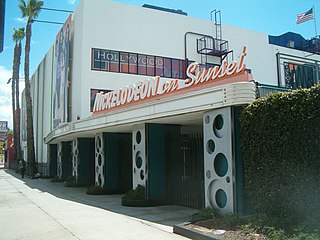
The Earl Carroll Theatre was a historic stage facility located at 6230 Sunset Boulevard in Hollywood, California. It was built by showman Earl Carroll and designed in the Streamline Moderne style by architect Gordon Kaufmann in 1938. The theatre has been known by a number of names since, including Moulin Rouge from 1953 to 1964 and the Aquarius Theater in the 1960s and 1970s. From 1997 to 2017, it was officially known as Nickelodeon on Sunset, housing the West Coast production of live-action original series produced for the Nickelodeon cable channel.
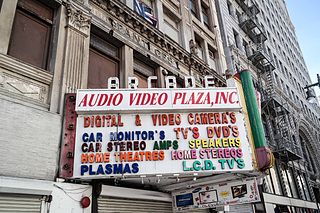
The Arcade Theatre is a historic former vaudeville and movie theater in the Broadway district of Los Angeles, California. Commissioned by real estate developer William May Garland in 1910, it originally operated under the direction of Alexander Pantages. In 1920, the Pantages operation moved to a new auditorium on 7th Street; thereafter, the theater became known as Dalton's Broadway for two years before ultimately taking the Arcade name in 1924 in association with the adjacent Spring Arcade building. Metropolitan Theatres later operated the facility as a grindhouse until its closure in 1992.

The Ricardo Montalbán Theatre is a theater in the Hollywood section of Los Angeles.
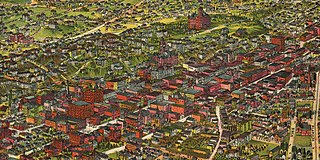
The late-Victorian-era Downtown of Los Angeles in 1880 was centered at the southern end of the Los Angeles Plaza area, and over the next two decades, it extended south and west along Main Street, Spring Street, and Broadway towards Third Street. Most of the 19th-century buildings no longer exist, surviving only in the Plaza area or south of Second Street. The rest were demolished to make way for the Civic Center district with City Hall, numerous courthouses, and other municipal, county, state and federal buildings, and Times Mirror Square. This article covers that area, between the Plaza, 3rd St., Los Angeles St., and Broadway, during the period 1880 through the period of demolition (1920s–1950s).

The Roxie Theatre is a historic former movie theater in the Broadway Theater District of Los Angeles, California. The venue opened in 1931 as the last theater to be built on Broadway. Architect John M. Cooper's Art Deco design of the Roxie remained the only theater of that style in the downtown neighborhood. In 1978, Metropolitan Theatres converted the space into a Spanish-language filmhouse. Following the Roxie's closure in 1989, the lobby was converted into retail space whereas the auditorium was left intact.
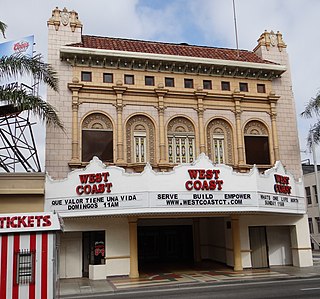
The New Walker Theatre is a historic former movie theater on Main Street in Santa Ana, California. Opened in 1924, it came under new management as the Fox Walker Theatre in 1925 and later operated as the West Coast Theatre. Theater specialist firm Boller Brothers designed the building in the Mission Revival and Moderne styles; it was the group's 100th project. The New Walker Theatre was added to the National Register of Historic Places on February 19, 1982. Following its closure as a movie theater in the 1980s, the auditorium was later purchased and renovated by a church in 1991.




















